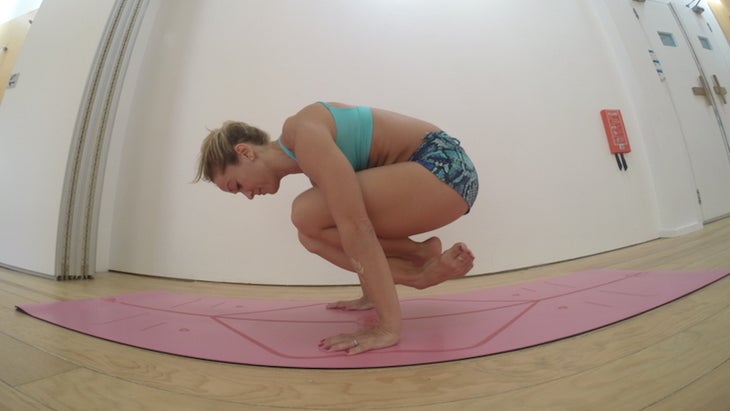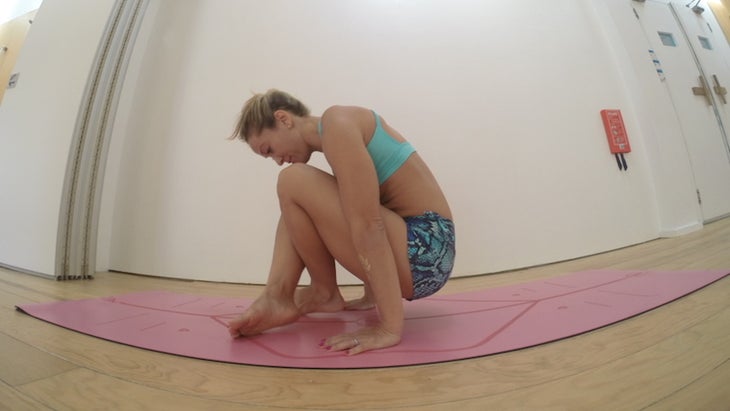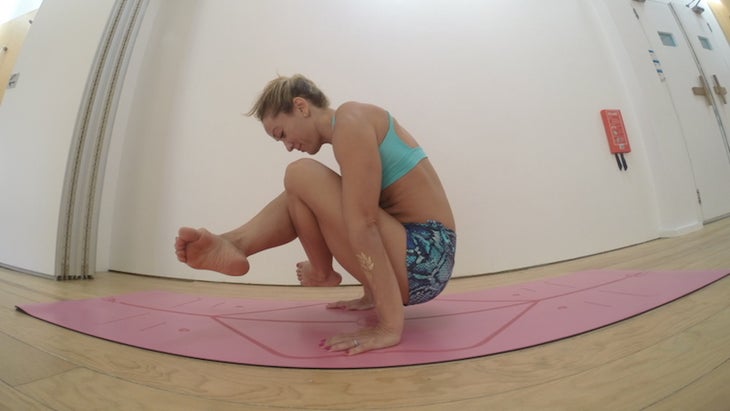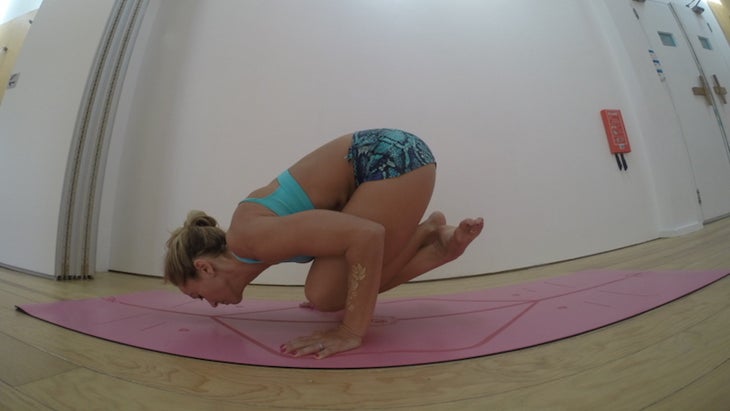Heading out the door? Read this article on the new Outside+ app available now on iOS devices for members! Download the app.
Watch the video: Jump Backs with Kino MacGregor

Jumping back is one of the most challenging movements often seen in vinyasa flow classes, but it is originally the hallmark of the Ashtanga Yoga method. For many yogis, it’s a tedious 10-year journey before they can execute the transition with any success. Beginners often have no idea where to start to build the strength to lift up and jump back. And when I started the practice, no one could break down the movement for me. Everyone who could do it simply said that they “applied mula bandha and lifted up.”
To say it was frustrating would be an understatement. After many years, I had an epiphany while watching my students practice: No amount of magical lift in the center of the pelvis can make up for weak shoulders. If your shoulders aren’t strong enough to give your body a solid foundation then you cannot jump back, no matter how hard you squeeze.
So many people think that their arms are too short or that their thighs are too heavy to jump back. I empathize, because I often share this sentiment. I can say from direct experience that if you put in the work over many years of practice, your body will change and you will be able to do things that now seem impossible. The step-by-step method that follows will teach you how to build strong shoulders and eventually jump back. Whether you put in the work every day to build physical and mental strength is up to you.
See also Kino MacGregor Challenge Pose: Jump Through
Step 1: Set Up

Starting in Dandasana (Staff Pose), cross your shins, lift your knees and fold your torso toward your thighs. Flex your feet, placing their outer edges are on the floor. Place your hands forward of your hips, aligned with the middle of your thighs, perhaps slightly wider than shoulder-width apart. This alignment will let you lean your body weight forward and lift up in a forward direction rather than vertical (which is much harder). Fold your body inward toward your centerline with a deep spinal flexion. Engage your abdominal muscles, pull your lower ribs in, and lift your pelvic floor. Spread your shoulder blades and engage your biceps.
Step 2: Lift Up

Next lean forward into the solid foundation of your arms while engaging your core to lift your hips. Beginners should leave their feet on the ground and focus only on lifting their hips to start. Eventually the same engagement of the arms and core will lift the whole body, legs and hips completely off the floor.
Don’t stress if that seems impossible! Surrender to the long journey and give yourself 10 years to see results. Even though you may not be able to see it working, yoga is transforming your nature each time you practice.
See also Tolasana (Scale Pose).
Step 3: Halfway Point

Directly from the lift up position walk your feet back, inch by inch, until your knees are pointing between your arms, your shins are crossed and your feet are behind your wrists. Do not attempt to go directly from the lift up to Chaturanga Dandasana (Four-Limbed Staff Pose) without pausing in the halfway point, especially if your feet are on the floor. If you by-pass this halfway point, you will deprive yourself of the process of developing the true strength to lift up and jump back.
Challenge Step: Halfway-Point Hover

With practice, eventually you will be able to keep your feet off the floor and float from the lift up position to the halfway point. However, beginners are advised not to focus on that from the start. Simply build the movement mechanics that will take you through the full progression.
See also Kathryn Budig Challenge Pose: Crow Jumpback
Step 4: Bend Your Elbows

Maintaining the halfway-point shape with your feet on the ground, stabilize the muscles of the shoulder girdle by pulling your shoulder blades down your back. Bend your elbows straight back, keeping them in line with your shoulders. Pitch your bodyweight forward, rounding your back and aiming the top of your head toward the ground without touching it down. If you feel yourself collapsing forward you are most likely doing it properly. Once your shoulders move forward over your fingertips walk your left foot all the way back to Chaturanga Dandasana (Four-Limbed Staff Pose) and allow the right foot to follow. Do not straighten the arms. Instead end directly in Chaturanga.
Challenge Step: Full Jump Back

Eventually you will be able to keep both your feet off the ground while bending your elbows, engaging your core, and floating back to Chaturanga Dandasana. However, if you’re a beginner, focus only on strengthening the shoulders and core to maintain healthy alignment throughout the transition. Bending the elbows is probably the most awkward and uncomfortable part of the jump back, but it is the missing key that so many students lack. Put your emphasis here and you will be jumping back sooner than you can imagine. Don’t worry about jumping high—or jumping at all. Instead keep your movement, low, humble and close to the centerline of the body.
See also 9 Poses to Master the Pick Up and Jump Back
And for your return trip, try As Seen In Sadie Nardini’s Class: Lightest Yoga Jumps Ever
About Our Expert

Kino MacGregor is a self-professed Handstand lover (just check out her Instagrams). She’s also a Pattabhi Jois-certified Ashtanga Yoga teacher who travels worldwide, author of three books, featured in six Ashtanga Yoga DVDs, and co-founder of Miami Life Center, where she and her husband Tim Feldmann are based.
Catch up with her on:
Twitter: @kinomacgregor
Instagram: @kinoyoga
Facebook: @kinoyoga